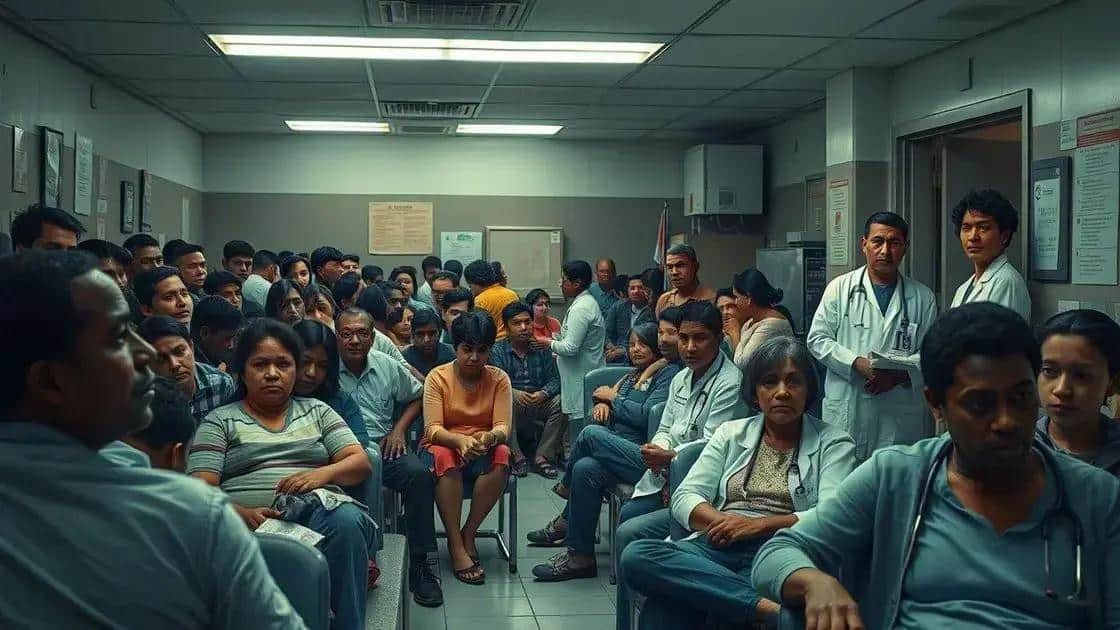Wrong low income health care: Are we ignoring the issue?

Inadequate access to health care for low income populations leads to severe health disparities, worsened health outcomes, and increased economic strain, necessitating community engagement and supportive policies for effective solutions.
When we talk about wrong low income health care, it’s more than just numbers. It’s about real people facing daily struggles to access essential services. How does this reality shape our communities and what can we do to address it?
Understanding low income health care challenges
Understanding the challenges of low income health care is essential for grasping the full scope of health disparities. Many individuals face obstacles that prevent them from accessing necessary medical services. These barriers can lead to severe consequences for their overall well-being.
Common Barriers to Access
For those with limited financial means, several key factors can hinder access to health care:
- High out-of-pocket costs for medical care.
- Lack of transportation to health facilities.
- Inadequate availability of providers in low-income areas.
- Difficulty navigating complicated health insurance systems.
Each of these barriers contributes to unmet health needs within low income populations. For instance, many individuals may avoid seeking care due to the fear of incurring debt or additional financial strain.
Societal Impacts
The implications of low income health care challenges extend beyond the individual. Communities suffer when large groups of their members cannot access timely health services. This leads to increased rates of preventable diseases and overall poorer health outcomes.
Additionally, the economy can be affected as a result of a less healthy workforce. When people cannot receive adequate care, productivity declines, creating a ripple effect throughout various sectors. Addressing these challenges is not merely a matter of ethics, but also essential for the stability and growth of society.
Who is affected by wrong low income health care?
Identifying who is affected by wrong low income health care is vital for understanding the broader implications of health disparities. Various groups are disproportionately impacted, leading to a cycle of poor health outcomes.
Vulnerable Populations
Among those affected are individuals from low-income backgrounds, particularly:
- Families with children who depend on subsidies for health coverage.
- The elderly who may struggle to pay for medications and services.
- Unemployed individuals who lack financial resources to seek medical care.
- Minorities facing systemic barriers in accessing quality services.
These groups often experience more pronounced health challenges, as many are unable to afford necessary treatments or preventive care. The consequences can be severe, as untreated conditions often lead to greater health complications.
Geographical Disparities
Location also plays a significant role in who suffers from wrong low income health care. Rural areas frequently lack adequate facilities and healthcare professionals, putting residents at a major disadvantage. In urban settings, while facilities may be available, overcrowding and resource allocation can limit access for low-income individuals.
This imbalance contributes to a situation where certain populations are continuously overlooked, leading to a decline in their overall health and well-being. By acknowledging these disparities, communities can begin to address the needs of all citizens better.
The impact of inadequate health care access

The impact of inadequate health care access stretches far beyond individual health challenges. It affects families, communities, and even the economy at large. When people cannot receive the care they need, the consequences can be dire.
Health Outcomes
One of the most immediate effects of inadequate access is the deterioration of health outcomes. Without timely medical intervention, individuals may experience:
- Worsening chronic conditions such as diabetes and heart disease.
- Increased rates of preventable diseases.
- Higher mortality rates due to lack of preventive care.
- Delayed diagnosis of serious health issues.
These factors create a cycle of poor health that can affect generations within families.
Economic Consequences
From an economic standpoint, inadequate health care access can be costly. When populations neglect their health, the ripple effects can lead to:
- Higher health care costs in emergency situations.
- Loss of productivity due to illness.
- Increased financial strain on families.
- Higher health insurance premiums as more claims arise.
Communities with inadequate health access often face strained health systems, further deteriorating the situation.
Inadequate health care access not only affects the immediate health of individuals but also has long-lasting implications for their future and that of their communities. When health needs are continually unmet, the potential for growth and development diminishes significantly.
Strategies for improving health care for low income populations
Implementing effective strategies for improving health care for low income populations is crucial for addressing health disparities. Various approaches can help bridge the gaps in access and quality of care.
Community Outreach Programs
One effective strategy is to enhance community outreach programs. These initiatives connect health services with low-income families by:
- Providing education about available health services and screenings.
- Facilitating transportation to medical appointments.
- Offering home visits for those unable to travel.
- Organizing health fairs that provide free screenings and resources.
Through community engagement, awareness about health resources significantly increases.
Telehealth Services
Another promising approach is utilizing telehealth services. This technology allows patients to access care remotely, reducing barriers posed by transportation and scheduling. Benefits include:
- Increased access to specialists without geographical limitations.
- Convenience for patients with mobility issues.
- Reduced wait times for consultations.
- Lower overall costs for patients and health systems.
By embracing telehealth, healthcare providers can extend their reach and offer more timely support to low-income individuals.
Policy Advocacy
Advocating for policies that prioritize low-income populations is essential. Policymakers can work towards:
- Expanding Medicaid and subsidized insurance options.
- Increasing funding for community health centers.
- Creating incentives for healthcare providers to serve in underserved areas.
- Ensuring that all medical facilities meet accessibility standards.
These policy changes can lead to improved health outcomes and more equitable access to care.
By integrating these strategies, we can create a more inclusive healthcare system that addresses the needs of low-income populations effectively. Collaboration among communities, healthcare providers, and policymakers is vital in this pursuit.
Navigating policies for better health care solutions
Navigating policies for better health care solutions can be complex, but understanding the landscape is crucial for improving access to care. Policies impact how health services are delivered and who benefits from them.
Understanding Key Policies
Several critical policies shape health care for low-income populations. These include:
- Medicaid expansion: This policy allows more low-income individuals to gain health coverage.
- The Affordable Care Act (ACA): Aims to reduce the number of uninsured by providing subsidies for health insurance.
- Community health center funding: Ensures resources for clinics serving underserved areas.
- Prescription drug pricing regulations: Affects affordability for essential medications.
Being aware of these policies helps communities advocate for their rights and push for necessary changes.
Advocacy and Community Engagement
Engaging in advocacy is essential for shaping health care policies that can lead to better solutions. Communities can:
- Form coalitions to represent the health needs of low-income individuals.
- Educate local leaders about the importance of equitable health care access.
- Participate in public meetings to voice concerns and suggestions.
- Utilize social media to raise awareness about policy issues.
Such activities foster greater engagement and can lead to meaningful policy changes.
Resources and Support
Various organizations provide resources to help navigate the complexities of health care policies. These resources include:
- Legal aid services that assist individuals with understanding their rights.
- Nonprofits focused on health equity that provide information and advocacy tools.
- Workshops and seminars on health care navigation strategies.
- Online platforms that offer updated policy information and resources.
By utilizing these resources, individuals can better understand their health care options and the policies that affect them.
In conclusion, addressing the challenges of low income health care requires a multi-faceted approach. By understanding who is affected and the impacts of inadequate access, we can advocate for better policies and solutions. Community engagement plays a critical role in bringing about change. With the right strategies and support, we can create a more equitable health care system that benefits everyone.
FAQ – Frequently Asked Questions About Low Income Health Care
What are the main challenges low income populations face in accessing health care?
Low income populations often struggle with high costs, lack of transportation, and availability of services, leading to inadequate health care access.
How can community outreach programs improve health care access?
Community outreach programs can inform families about available services, provide transportation, and offer free screenings to enhance accessibility.
What role does telehealth play in improving health care for low income individuals?
Telehealth allows low income individuals to consult with healthcare providers remotely, reducing barriers like transportation and wait times.
How can individuals advocate for better health care policies?
Individuals can engage in advocacy by participating in local health initiatives, educating leaders about health needs, and joining community coalitions.






